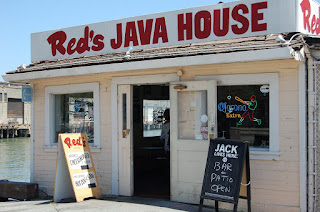Stellina is smack in the middle of this small West Marin town, across the street from Toby's Feed Barn and a few steps from two other of my usual stops: Bovine Bakery and Point Reyes Books. It's a casual place (everyone seems to be in jeans and hiking boots) , in a corner building where a bare-bones Mexican restaurant once stood.
 The food reminded me a bit of Delfina in San Francisco, with clean flavors of simple, local ingredients prepared very well. We started with conserved tuna and bean salad that had a hint of fennel, then split a pasta dish and entree: orecchiete with rapini and housemade sausage and a Tomales Bay seafood stew full of mussels and clams in a rich flavorful broth. The earthy, crispy bread served to sop up the broth is from Brickmaiden, a bakery set up in a backyard cabin of a nearby house that produces one of my favorite breads in the world. Everything was delicious and, to cap it off, the dessert was a dreamy -- and tangy, creamy -- chevre cheesecake topped with caramelized almonds and surrounded by huckleberry sauce.
The food reminded me a bit of Delfina in San Francisco, with clean flavors of simple, local ingredients prepared very well. We started with conserved tuna and bean salad that had a hint of fennel, then split a pasta dish and entree: orecchiete with rapini and housemade sausage and a Tomales Bay seafood stew full of mussels and clams in a rich flavorful broth. The earthy, crispy bread served to sop up the broth is from Brickmaiden, a bakery set up in a backyard cabin of a nearby house that produces one of my favorite breads in the world. Everything was delicious and, to cap it off, the dessert was a dreamy -- and tangy, creamy -- chevre cheesecake topped with caramelized almonds and surrounded by huckleberry sauce.You can't visit this area without taking a long walk somewhere beautiful -- this is, after all, a terrific place for a weekend getaway. We headed out to the long swath of white sand and surf at Limantour Beach in Point Reyes National Seashore for a stroll and nap in soft, cushy dunes. The beach, a Marinite favorite for dog walking, kite flying, bird watching and simply enjoying, is about a 20- to 25-minute minute drive west of Point Reyes Station.
My life isn't usually this decadent but this was the second day of great eating. The previous day I met up with two friends at Della Fattoria in downtown Petaluma. Lunch at this bakery-cafe turned out to be sandwich heaven because of the lovely breads made from a variety of organic flours that Della Fattoria bakes in its wood-fired brick ovens (in San Francisco, the loaves are sold on Saturday mornings at the Ferry Building). We split three grilled panini: a croque baton of ham and gruyere, a gruyere and apple and a smoked salmon and egg salad, which were served with a crispy green salad. Sorry that I forgot my camera that day. Trust me, these are some terrific sandwiches.






































.jpg)












